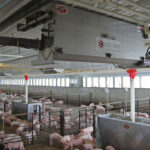Thermochemical Processing: Converting Biomass into Fuels and Chemicals
By: Robert C. Brown, Director, and Robert Mills, Communications Specialist, Bioeconomy Institute, Iowa State University The use of fermentation to produce ethanol from corn and other biomass is well known in the agricultural world. There are, however, other technologies that can...
Thermochemical Processing: Converting Biomass into Fuels and Chemicals
By: Robert C. Brown, Director, and Robert Mills, Communications Specialist, Bioeconomy Institute, Iowa State University The use of fermentation to produce ethanol from corn and other biomass is well known in the agricultural world. There are, however, other technologies that can...By: Robert C. Brown, Director, and Robert Mills, Communications Specialist, Bioeconomy Institute, Iowa State University
The use of fermentation to produce ethanol from corn and other biomass is well known in the agricultural world. There are, however, other technologies that can convert biomass into fuels and chemicals. Foremost among these are thermochemical processes, which use heat and catalysis to break down biomass to intermediates that can be upgraded to transportation fuels.

Thermochemical processing uses heat and pressure to convert various types of feedstocks into fuels and chemicals.
One advantage of thermochemical processing is that the end result can be “drop-in fuels,” those that are fully compatible with the existing fuel infrastructure. While not perfect, these drop-in fuels are good enough to run in today’s engines without modification.
Another advantage to thermochemical processing is that most systems can work with a variety of biomass feedstocks. Often the feedstock is lignocellulosic biomass, such as corn stover, switchgrass, miscanthus, wood, etc. But thermochemical processing can also use lipid-rich biomass such as distillers dried grains and algae as well as mixed wastes from commercial and municipal sources.
There are two basic types of thermochemical processing, indirect and direct liquefaction. Indirect liquefaction includes gasification, where the solid biomass is heated to create synthesis gas, or syngas, that is subsequently upgraded to liquid fuels. Various catalysts are then used to convert the gas into alcohols or hydrocarbons. The advantages of gasification is that the process produces a uniform product and it is commercially proven. Gasification, however, requires technologies to clean the gases, which are still under development, and the capital costs can be high.
Direct liquefaction uses heat and pressure to convert the biomass into liquids which can then be further upgraded into finished products. Direct liquefaction includes pyrolysis and solvent liquefaction. In the case of pyrolysis, biomass is heated in the absence of oxygen. The process yields bio-oil, syngas, and a solid product known as biochar. The bio-oil can be upgraded to drop-in fuels. Pyrolysis can be performed at relatively small scales, allowing it to take place close to the source of biomass rather than moving biomass to one large, centralized processing facility. One of the major problems with pyrolysis is that the bio-oil is unstable, complicating its conversion into fuels.

Iowa State University researchers discuss a new pyrolysis pilot plant during its construction. The plant is now up and running and is used to research the multi-stage fractionation of bio-oil, a process that promises a way to economically convert biomass into many value-added products.
At Iowa State University, we have invented a process to condense the pyrolysis gases in fractions, resulting in better, more stable products. The economics of fast pyrolysis are promising. In addition to producing fuels and chemicals from the bio-oil, the biochar may also have economic value. Consisting mostly of carbon, biochar can be used a soil amendment, helping retain moisture and nutrients. There is also research underway to use biochar as a filter medium for purifying water.
Solvent liquefaction, or solvolysis, is similar to pyrolysis except that it is performed in a solvent at elevated pressure. Though the fundamental chemistry of solvolysis is not well understood, the technology has promising economics. The process can upgrade bio-oil in a way similar to oil refining, and it can create sugars which can be further upgraded without expensive enzymes.
In addition to extensive research into thermochemical technologies, there are also many efforts underway to commercialize these technologies. Like all start-ups, these efforts have met with various degrees of success. There are, however, several pilot-scale systems being tested and commercial plants being built.
Bioenergy is a complex topic. There are many pathways from raw material to finished product. What’s more, bioenergy technology must be viewed in context of larger energy issues and policies. You can learn more in a book written for the general public, “Why are We Producing Biofuels,” by Robert C. Brown and Tristan R. Brown. The book is available on Amazon. You can read the first chapter for free online at: http://www.brownia.com/content/whyareweproducingbiofuels_excerpt.pdf.



